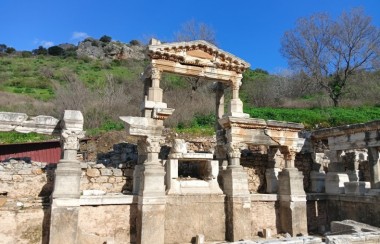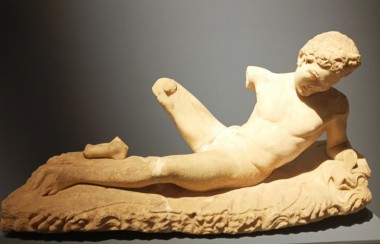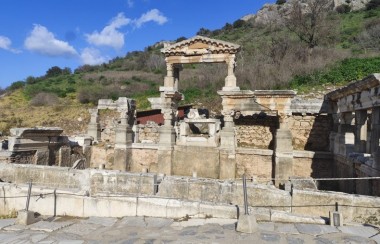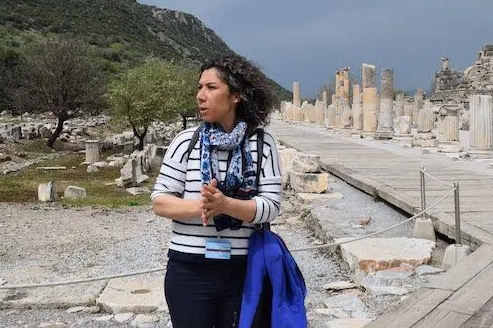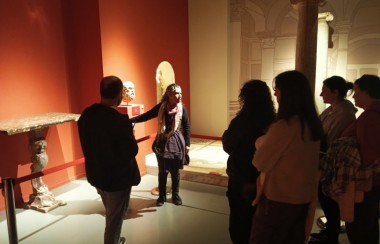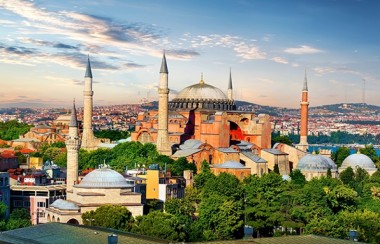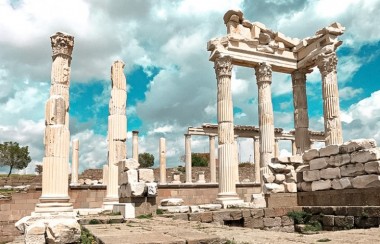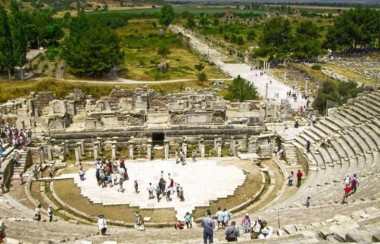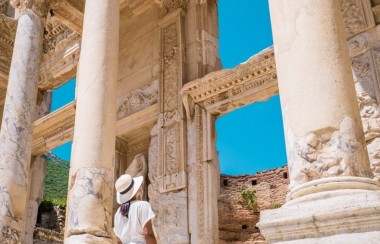The look at the north-eastern side of the Curetes Street offers us a glimpse into the secrets of water supply to Ephesus, as in this part of the city numerous monuments dedicated to this function were erected. The first one of them, as one walks down the street, is the Trajan's Nymphaeum. It has the shape of a pool surrounded on three sides by a two-storey structure. Like Rome, ancient Ephesus was also a city of fountains. Nowadays, with the running water readily available in our kitchens and bathrooms, we frequently underestimate the function of public fountains, treating them as a purely decorative element of the cityscape. However, in ancient cities of the Roman era, the majority of households had to draw drinking water from such fountains, and every day citizens, servants, and slaves rushed with vessels and buckets to fill them at the public fountains. These structures varied from simple ones to the elaborate monuments paid for by wealthy sponsors to commemorate their names or pay respects to the rulers of the Empire.
Trajan's Nymphaeum definitely belongs to the second category. This monumental building was erected in honour of Artemis of Ephesus and Emperor Trajan by Tiberius Claudius Aristion and his wife as an inscription informs us: "Claudius Aristion, thrice asiarch and neokoros, with his wife Julia Lydia Laterane [...] daughter of Asia, high-priestess and prytanis, he dedicated the [...] water, having brought it 210 stadia through the water conduit he constructed, and the water reservoir, with all its decorations, at his own expense, to Ephesian Artemis and to the Emperor Nerva Trajan Caesar Augustus Germanicus Dacicus and to the fatherland."
In order to realise the massive dimensions of the Trajan's Nymphaeum, it is necessary to visualise Curetes Street in its heyday, when it was a colonnaded thoroughfare, with two parallel rows of columns running from its beginning to the end. The nymphaeum, around 9.5 meters high and 17 meters long, slightly jutting outwards, dwarfed all the surrounding area. At least ten statues were located in the various niches of the fountain. During the archaeological excavations of the nymphaeum, the researchers found the statue of Aphrodite, two statues of Dionysos, naked and clothed, a young hunter symbolising the founder of the city, Androklos, Emperor Nerva, some women, and one satyr in a lying position. All of these findings are exhibited in the Ephesus Museum in Selçuk.
The most important decoration of the fountain was the colossal statue of Emperor Trajan, twice the size of other statues, standing in the centre of the building, from which the water flowed into the pool. The emperor was depicted with a globe under his feet, in a nude heroic posture according to the Greek tradition. Unfortunately, only the base of the statue and imperial feet have been preserved.
The fountain was ornamented with the Corinthian and composite columns. It had not one but two ornamental pools, one in the front and one at the rear, with two tiers of columns. The pipes filled the pools with the water. When the back pool was full, the water flew via a channel into the front pool.
Who was the sponsor of this impressive monument? Tiberius Claudius Aristion, a prominent citizen of Ephesus, started his political career as grammateus — the secretary of the people. Then, he held the offices of prytanis, the president of the city council of Ephesus, and gymnasiarchos, the magistrate who had charge of the gymnastic and literary instruction. As such, he sponsored the provision of oil for the city's main gymnasium. Finally, he reached the positions of archiereus, the high priest of the imperial cult, and neokoros, the guardian of the imperial temple. It is quite possible that he was personally responsible for the erection of the Temple of Domitian, later converted into the Temple of the Sebastoi.
Ariston's popularity and wealth brought him the jealousy of some people as attested by Pliny the Younger who explains that: "Claudius Aristo, the leading citizen at Ephesus, a man of great generosity, and who had won popularity by innocent means, pleaded his own case. His popularity had made people envious of him, and some of his enemies, who were utterly unlike him in character, had suborned a man to lay information against him. So he was acquitted, and his reputation vindicated." When Ariston died, he was buried within the city walls, as was the common practice with the most influential citizens of Ephesus. His sarcophagus was later moved to the vicinity of the Androklos Heroon, as it has already been mentioned in the discussion of that monument.
Related Shore Excursions
Explore Ephesus History with our Shore Excursions .
Roman Heritage & Ottoman Marvels
Blue Mosque, Byzantine Hippodrome, Hagia Sophia, Mevlana Bazaar, Topkapi Palace
Pergamum & Asklepion
The Acropolis and the Asklepion of ancient Pergamum, both listed among the top 100 historical sites...
Archaeological Ephesus Tour
Majestic Ephesus takes you on an unforgettable journey through history; etched on minds as the...
Ancient Ephesus
Ephesus comprises successive Hellenistic and Roman settlements founded on new locations, which follo...

